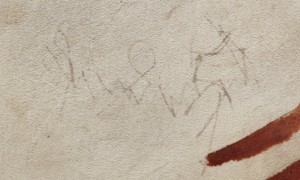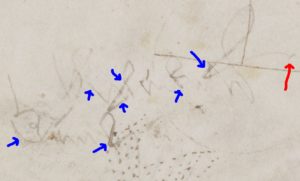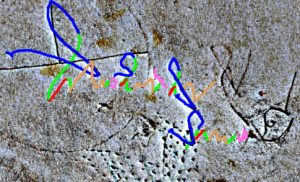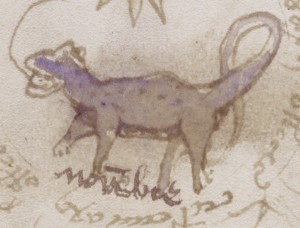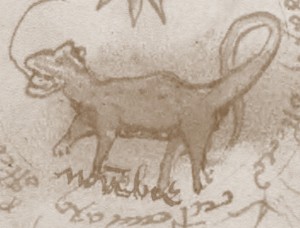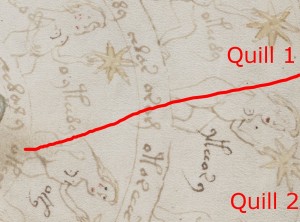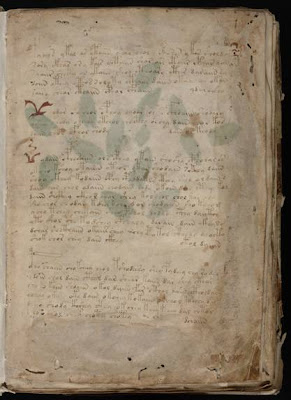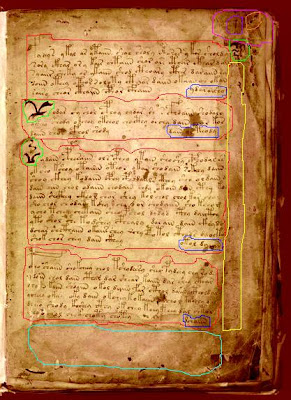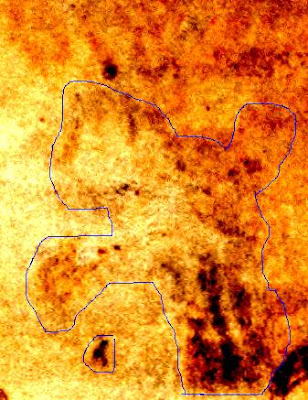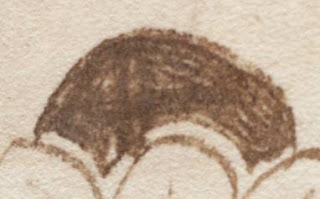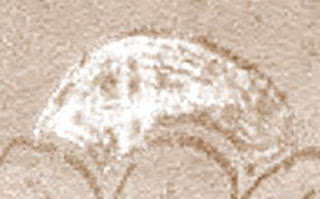As a Voynich Manuscript marginalia cognoscente, I’m always alert for new angles on the various incidental marks apparently added by its later owners. So, when Tim Tattrie left a comment about the “chicken scratch” marginalia on my recent Voynich-frontiers-circa-2010 post, I thought it was probably time to revisit them here.
Tim’s query was whether anyone had pursued the initials scribbled on f66v and f86v3: he noted that these were “clearly the same downward swept doodle of two or three letters (h?r), and because it is repeated in two folios, leads one to speculate its the initials of either the author, or an owner.” This almost exactly echoes what Jon Grove said on the Voynich mailing list (11 Sep 2002), that “It seems to consist of three connected downstrokes followed by a longer upstroke with a loop and final flourish, almost like ‘wR’ but not quite. It’s certainly not a random scribble. If it is a signature or monogram then it might help to establish dates and/or locations for the MS. ” To which Dana Scott replied at the time: “Notice that the single line ‘signature’ in f66v is essentially the same as the top line ‘signature’ in f86v (there are some differences to the right of each line).”
OK, so let’s look at them in all their hi-res glory. Firstly, the chicken scratches on f66v:-
And now here are the chicken scratches on f86v3. Palaeographically, I think this is much more interesting, because you can see what looks like a scribal line ending stub (in red), and lots of places where the quill has opened up under pressure in different directions (in blue). Some years ago, I suggested that these scratches might be an ink blot transfer of Georg Baresch’s signature, because if you rotate and flip them you can see letter-sequences that vaguely resemble “g///g”:-
However, there is a codicological nicety to consider here, which is that if you reorder Q8 (Quire #8) to place the astronomical (non-herbal) pages at the back, and also follow Glen Claston’s suggestion by inserting the nine-rosette quire between (the reordered) Q8 and Q9, what you unexpectedly find is that the f66v and f86v3 chicken scratches move extremely close together. If this is correct, it would imply that the doodles were added very early on in the life of the VMs, probably earlier even than the fifteenth-century hand quire numbering (and hence probably early-to-mid 15th century). And this would rule out Baresch by a couple of centuries or so. 🙂
But I have a possible bombshell to drop here. If I once again rotate and reverse the f86v3 chicken scratch, this moves the ornate scribal line-ending to the start, implying that it was the start of a line. Following the lines through from there on a Retinex-enhanced version of the page, I now suspect we know enough to separate out the letters one at a time:
If I’ve got this correct, then the letter sequence here is:-
- (blue) “S“
- (green) downstroke
- (red) “i“
- (green) downstroke
- (orange) “m“
- (green) downstroke
- (purple) “o” / “n” / “t” [though it’s not entirely clear which]
So, something like “Simon”, then. What is particularly curious is that I have elsewhere suggested that the top-line marginalia on f116v reads “por le bon simon sint” in what I suspect was the handwriting of either the original author or someone very close to him/her. If that is right, then we can piece together a little bit of the VMs’ early 15th century provenance: that what we are looking at here is the ink blot signature of someone named (something close to) “Simon Sint”, who was very possibly the person to whom that original author gave the manuscript. Though it’s hard to be sure, this person may well be the same one who added the earliest set of quire numbers (which I called “Quire Hand 1” in The Curse)… but we’ll leave that issue for another day, that’s probably quite enough wobbly inferences for one post! 🙂
OK, as explanations go it’s not 100% convincing as yet, but all the same it’s a pretty joined-up historical hypothesis that could (and indeed should) be codicologically tested, which is more than can be said about most speculative VMs theories. I’m pretty sold on the idea that this is telling us we should be looking for someone (possibly a monk) in Southern France / Savoy called something not too far from “Simon Sint” circa 1450, and that this is his signature (i.e. he cared so little about the VMs that he used it as blotting paper, shame on him). Jeez, how specific do I need to be? 🙂
